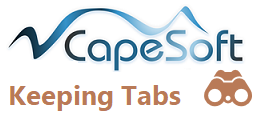Using Keeping Tabs in Two Easy Steps!
NOTE: For
Multi-DLL apps, you need to
do this in every app where you want KeepingTabs to perform its magic.
- Add the global extension (Global -> Extensions -> Insert->
Activate CapeSoft KeepingTabs).
On the Options tab:
- Turn KeepingTabs on locally - if you check
this, this means that KeepingTabs will be disabled by default and
requires manually enabling on the procedures where you require it.
- You can either store settings in the Registry
or an INI file.
- Selecting INI storage allows you to select the INI file which
KeepingTabs will use to store the information it requires
(Application INI by default). To use an alternative INI file, you
can select the Other option and then enter the name of the ini
file to store (use quotes for a constant or use a variable name).
- Selecting Registry storage, allows you to select the registry
key path. This is the path within the HKEY_Current_User key.
KeepingTabs will create
- By default, both the Tab selected and the Listbox
Format will be stored, but you can disable either one
globally here (by checkng the respective checkbox).
- If your app is ABC, and you are making use of the Extended
Options / Enable Sort Header feature on your browses, then you can
turn on Column Sort Order.
- List Box Settings - allows you to set the default LineHeight and
GridColor to be used throughout this entire application (which you
can override these locally). If you don't want the LineHeight and
GridColor set by default, then clear these template prompt fields.
You can use Makeover to set the LineHeight and the GridColor for
lists, so to avoid conflict where both products exist in your
application, you need to choose whether Makeover or KeepingTabs
controls the GridColor and LineHeight.
- Turn ActiveInvisible on for all browses - ActiveInvisible is off
by default, which means that you need to manually issue a browse
redraw in wizarded sheets (with browses on the tabs that aren't
initially shown). Checking this will make sure that your browses
have data when you tab to them.
Click OK to close the Global Extension dialog box and OK to close the
application Global window.
For testing and debugging you can globally disable KeepingTabs on the
Global Extension by checking the Disable all KeepingTabs Features
checkbox.
Disabling KeepingTabs on a particular
procedure:
You can disable Keeping tabs for a particular procedure by right Clicking
on the procedure and choose "Extension", then checking the Disable
KeepingTabs here checkbox on the local KeepingTabs procedure.
You can also disable the LineHeight and Gridcolor use for a particular
procedure as well on the Options tab (by checking the respective
checkboxes there).
Disabling or change the KeepingTabs behaviour for a specific
Control:
You can also disable KeepingTabs for a particular for a particular control
by right clicking on the procedure and choosing "Extensions". Select the
KeepingTabs extension from the list and click on the
Options
tab.
The Options tab contains a list of the controls that KeepingTabs affects.
- Checking the Disable LineHeight here means that
KeepingTabs won't set the line height of all the browses on this
particular procedure.
- Checking the Disable Grid Color here checkbox
means that Keeping Tabs won't set the grid color of all the browses on
this particular procedure.
- You can specify the procedure
name. This is particularly useful where a list box gets
formatted differently for different things - or depending on the
procedure calling it (like Secwin's SetAccess window). You want each
instance (although it's the same list box) - to be stored differently
- You can specify whether you would like the ActiveInvisible to be
Default (i.e. taking the Global setting), or force it to either on or
off.
You can select a control from this list, then click on the Properties
button:
- Disable KeepingTabs for this control.
- Override LineHeight allows you to override the lineheight for that
specific list control.
- Override gridcolor allows you to override the gridcolor for that
specific list control.

